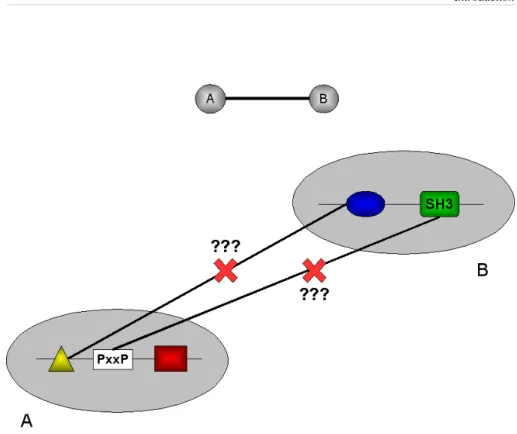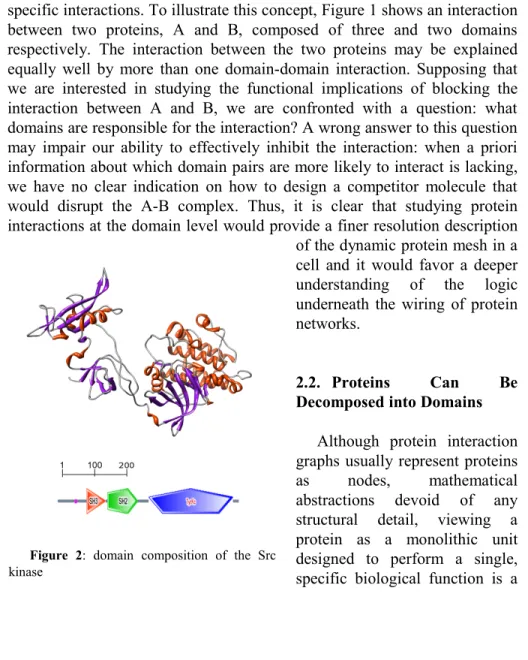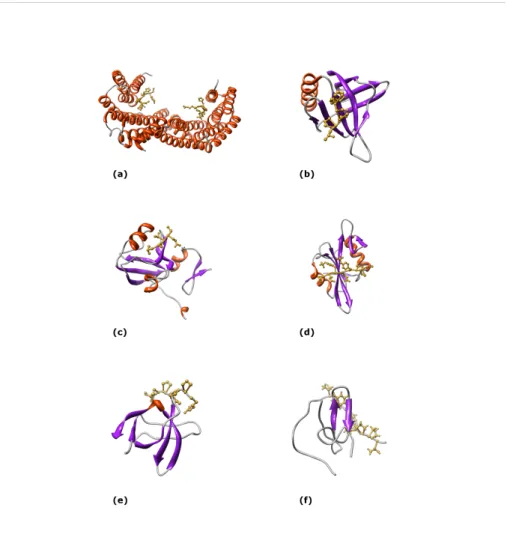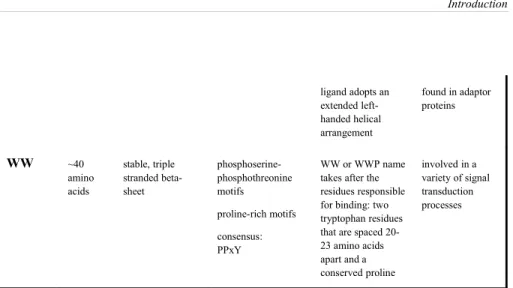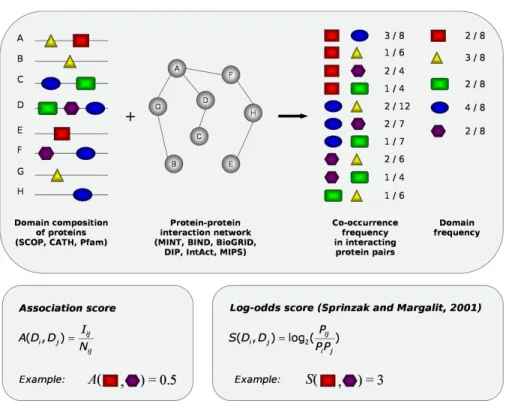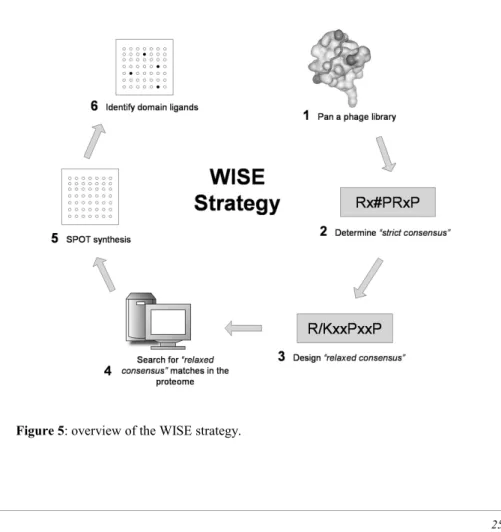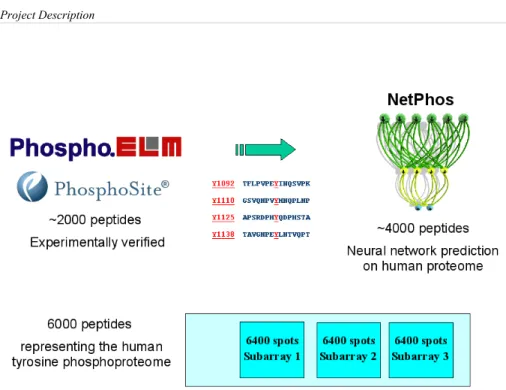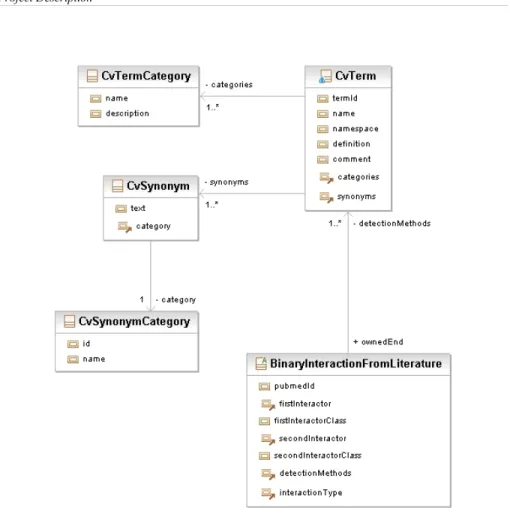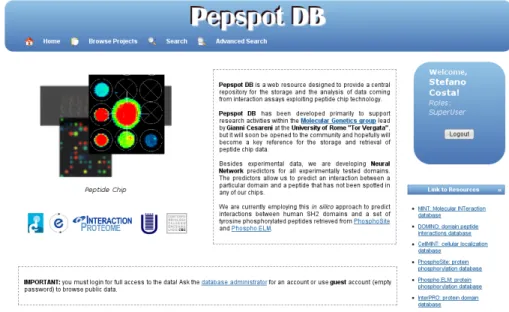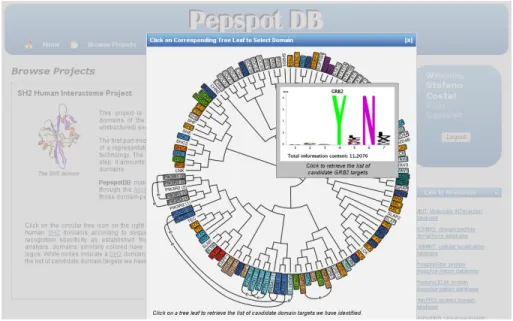UNIVERSITÀ DEGLI STUDI DI ROMA
"TOR VERGATA"
FACOLTA' DI SCIENZE MATEMATICHE FISICHE E
NATURALI
DOTTORATO DI RICERCA IN
BIOLOGIA CELLULARE E MOLECOLARE
XXI CICLO
PepspotDB: a database for the storage and analysis of
experiments based on peptide array technology
Stefano Costa
Table of Contents
1. Abstract...6
2. Introduction...8
2.1. Protein-protein Interaction Networks and their Shortcomings...8
2.2. Proteins Can Be Decomposed into Domains...11
2.3. Interaction Modules: Small Globular Domains Recognizing Short Linear Motifs...14
2.4. Methods to Detect Domain-Domain Interactions...18
2.5. Public Databases Containing Domain-Domain and Domain-Peptide Interactions...26
3. Project Description...28
3.1. The Context: Three Projects Studying the Specificty of Classes of Domains Recognizing Short Linear Motifs and a Class of Enzymes Recognizing Phosphorylated Substrates...28
3.2. PepspotDB: Aim of the Project...32
3.3. Database Design...34
3.4. Web Interface...50
3.5. Software Used for PepspotDB's Development...61
4. Results...64
4.1. SH2 Mediated Human Interactome Mapping Project...64
5. Conclusions...86
5.1. What We Have Achieved...86
5.2. Future Developments...90
5.3. Acknowledgements...91
6. Appendix...92
6.1. Methods to Detect Protein-Protein Interactions...92
6.2. Public Databases Containing Protein-Protein Interactions...97
Abstract
1. Abstract
The mapping of the “interactome” (i.e. the network comprising all possible physical protein-protein interactions naturally occurring within a cell or an organism) of living organisms is a key asset to promote the advancement of Systems Biology. Notwithstanding the numerous insights we have gained from the study of protein-protein interaction networks, currently available interactomes present several shortcomings, one of the more crucial being the lack of information regarding the regions involved in the interactions. Especially important in this respect are several families of conserved protein domains (e. g. SH2, SH3, WW, EVH1) that mediate protein-protein interactions by binding to short linear motifs.
Our group has recently devised a strategy based on peptide array technology to study on a large scale the target recognition specificity of domains binding to short peptides. Our approach consists of an experimental and a computational part: 1) the domains are profiled by testing them with ad hoc designed peptide arrays; 2) Neural Network based predictors are trained for each of the profiled domains and the predictions are combined in a Bayesian framework with information coming from multiple orthogonal sources to obtain an integrated interaction confidence score. The approach has been applied to the identification of all human protein-protein interactions mediated by SH2 domains.
To support the projects employing our approach, we have developed a brand new database-centered application, called PepspotDB, specifically designed to facilitate the storage and analysis of molecular interaction assays exploiting peptide array technology. We hope that PepspotDB will grow enough to become a prominent resource for the storage, analysis and retrieval of peptide chip data.
PepspotDB comes with a traditional relational database, where experimental results, computational predictions and data imported from the
Abstract
literature or other external sources are stored, a rich web application, providing a user-friendly, yet powerful, interface to the database, and a set of tools to automatically process raw experimental data, identify promising candidate binders and visualize sequence logos.
At the time of writing, PepspotDB contains more than 5 million records, comprising about 80 experiments and 55,548 domain-peptide interactions involving 70 SH2 domains and 7,972 unique peptides. These numbers are bound to more than double as new experiments involving other domain families are completed. Scientists studying protein-protein interactions mediated by domains recognizing linear peptides may find PepspotDB a precious resource to foster their own research.
Introduction
2. Introduction
2.1. Protein-protein Interaction Networks and their Shortcomings
The completion of the sequencing of the genome of numerous organisms has helped to realize that the observed increase in genome complexity is inadequate to satisfactorily explain the greater morphological, physiological and behavioral complexity of higher organisms. Increase in the intricacy of the network that controls the expression of gene products and their interactions has been invoked as a further level of complexity that might explain the differences observed at the organismal level.
Thus, compiling an exhaustive list of the genes and the proteins they encode is merely the first step towards a full understanding of cell functioning. In the great majority of biological processes, from signal transduction to immune response, from uptake and metabolism of nutrients to cell movement, from cytoskeleton organization to regulation of gene transcription and translation, proteins and protein complexes play a key role. In carrying out their functions, proteins form either stable or transient interactions, assembling macromolecular complexes that are often essential to fulfill their biological role. Mapping all the interactions among proteins in a cell would represent a fundamental starting point to explore the mechanisms regulating living systems behavior. The network comprising all possible physical protein-protein interactions naturally occurring within a cell is called “interactome”. The interactome constitutes a scaffold to which other genomic scale data may be attached to further elucidate cell physiology.
The interactome plays a major role in stimulating the growth of a new branch of biology, called “Systems Biology”. Systems Biology aims at
Introduction
gaining insights into the dynamics governing the behavior of complex biological systems, viewed as the result of the coordinated action of many elementary components connected to each other, eventually building an abstract model of the system capable of predicting the system’s response to any variation of input (internal parameters and environmental conditions). The availability of a map of all physical connections among proteins in the
Figure 1: protein A and B are composed of three and two domains respectively. Thus, the
interaction between protein A and B may be explained equally well by several possible domain-domain interactions (e.g. yellow-blue, white-green). Our ability to disrupt the A-B complex is a function of our knowledge of what domain pairs are more likely to interact.
Introduction
cell is mandatory to develop useful, biologically relevant mathematical models of cellular processes.
However, the information provided by standard experimental techniques for detecting protein-protein interactions may not be enough for the level of detail required by modeling. For instance, interaction data often contain no indication on post-translational modifications (PTM) that protein partners may have undergone, nor it is clear whether such modifications favor or hinder the interaction. Moreover, quantitative information on interaction affinity and kinetic parameters, crucial for describing the dynamic of assembly and disassembly processes, is only very rarely available. Finally, while the genome is essentially static and does not change during the life of an individual, the proteome and, consequently, the interactome is far more dynamic, varying its composition according to the cell cycle and environmental conditions. In other words, interaction detection techniques can only take a snapshot of the possibly occurring interactions in a particular moment of the life of a specific type of cell: by no means they provide an exhaustive description of the temporal and spatial evolution of the interactome.
Another severe limitation of current high-throughput approaches is that they are generally unsuitable for providing information on the protein regions involved in binding. Although atomic level details on protein interactions will only come from crystallographic studies of the 3D structures of multi-protein complexes (Aloy and Russell 2006), valuable insights into the mechanisms underlying the formation and functioning of protein networks can be achieved by considering the intrinsic modular nature of proteins. It is the domain composition of a protein that determines both the functions it can perform and its binding ability to form complexes with partner proteins. Elucidating the details of how proteins interact would allow us to pursue ambitious goals, such as modeling competitive binding, or designing in a rational way synthetic molecules targeted on inhibiting
Introduction
specific interactions. To illustrate this concept, Figure 1 shows an interaction between two proteins, A and B, composed of three and two domains respectively. The interaction between the two proteins may be explained equally well by more than one domain-domain interaction. Supposing that we are interested in studying the functional implications of blocking the interaction between A and B, we are confronted with a question: what domains are responsible for the interaction? A wrong answer to this question may impair our ability to effectively inhibit the interaction: when a priori information about which domain pairs are more likely to interact is lacking, we have no clear indication on how to design a competitor molecule that would disrupt the A-B complex. Thus, it is clear that studying protein interactions at the domain level would provide a finer resolution description of the dynamic protein mesh in a cell and it would favor a deeper understanding of the logic underneath the wiring of protein networks.
2.2. Proteins Can Be Decomposed into Domains
Although protein interaction graphs usually represent proteins as nodes, mathematical abstractions devoid of any structural detail, viewing a protein as a monolithic unit designed to perform a single, specific biological function is a
Figure 2: domain composition of the Src
Introduction
too simplistic description of reality. In fact, as we have mentioned, many proteins can be thought of as the assembly of smaller building blocks, termed “domains”, and therefore show an intrinsic modular nature. Figure 2 shows an example of a protein composed of three clearly distinguishable domains.
Although no universally agreed definition of domain exists, protein domains are usually identified and classified according to structural, functional and evolutionary criteria. A domain can thus be described as a compact, autonomously folding structural unit, which is conserved across evolution and is capable of performing a function, independently of the context of the protein it belongs to. Proteins can be composed of one (single-domain proteins) or more (multi-(single-domain proteins) (single-domains. Genome-wide structural assignments of domains have shown that domain composition complexity increases in proteins of higher order organisms: about two thirds of prokaryotic proteins are multi-domain, compared to 80% of eukaryotic proteins (Liu and Rost 2004). The variety we observe in the proteomes of living organisms may have been generated from a limited set of ancestral domains with different functions. Then, the evolution of protein repertoires may have been driven primarily by three forces: 1) duplication of gene sequences coding for one or more domains; 2) sequence differentiation by mutation and genetic drift, eventually resulting in the acquisition of new functions; 3) gene recombination, which promotes rearrangements in the sequential order of domains (Chothia et al. 2003; Bauer et al. 2005). This interpretation leaves us with a question: how novel polypeptide domains have arisen in the beginning? Recently, the observation of species-specific exons in the genomes of closely related species has suggested that the “exonization” of species specific intron sequences may play an important role in the genesis of domains. Furthermore, insertions and deletions occurring in already existing protein-coding sequences, or modifications to the length of sequence repeats may contribute to the process of acquiring
Introduction
Figure 3: three-dimensional structures of six protein interaction modules. (a) 14-3-3
Zeta/Delta dimer in complex with phosphopeptides (PDB code: 1QJB). (b) EVH1 domain of Homer protein homolog 1 in complex with peptide TPPSPF derived from Metabotropic glutamate receptor 5 (PDB code: 1DDV). (c) The third PDZ domain from the synaptic protein Psd-95 in complex with a C-terminal peptide derived from CRIPT (PDB code: 1BE9). (d) Src SH2 domain bound to doubly phosphorylated peptide PQpYEpYIPI (PDB code: 1NZL). (e) C-terminal Sem-5 SH3 domain bound to a proline-rich peptide from mSos
Introduction
new structural features of increased complexity in proteins, ultimately resulting in the creation of new polypeptide domains (Schmidt and Davies 2007).
2.3. Interaction Modules: Small Globular Domains Recognizing Short Linear Motifs
Proteins associate to form either stable or transient multi-protein complexes. The assembly of stable macromolecular complexes often requires high affinity interactions, involving large portions of the protein surfaces in the formation of the contact area. Such high-energy bonds are not easily disrupted and are thus well suited to confer stability on molecular machines such as the centrosome, the proteasome and others (Brooijmans et al. 2002). However, when flexibility and responsiveness are needed, e.g. in signaling pathways, such great stability would be a limitation. In fact, in highly dynamic contexts protein-protein interactions frequently involve a modular protein domain binding to a short amino acid sequence, termed “motif” (Pawson et al. 2002).
A motif is a sequence of 3 to 12 amino acids, which acts as recognition element for a modular protein domain that binds to it. Since these motifs are thought to be unstructured in their unbound form, they are often referred to as “linear” motifs: nonetheless, they may acquire a well-defined three-dimensional structure upon binding (for example, the proline rich motifs recognized by SH3 domains adopt a left-handed poly-proline II helix conformation). Short linear motifs often lie within disordered regions of the protein, for example they may reside in exposed flexible loops.
Binding motifs are recognized by a set of conserved protein interaction modules playing a major role in many biological processes: as an example, SH3, SH2, WW, EVH1, and PDZ domains are involved in protein
Introduction
trafficking and degradation, cytoskeletal organization, cell-cycle progression, cell survival and regulation of gene expression; plus, they can mediate the assembly of multi-protein complexes (PDZ domain containing proteins often act as scaffolds). Graphical representations of these and other interaction modules are illustrated in Figure 3 and their properties are summarized in Table 1. Each family of interaction modules has a defined conserved structure forming one or more ‘recognition pockets’, to which ligands bind. A small number of highly conserved amino acids have their side chains protruding outward in the recognition pocket. These mediate recognition of a specific signature in the ligand molecule, a short “core” motif of a few amino acids whose side chain chemical groups are complementary to those in the domain recognition pocket. Within a single domain family, the broad specificity encoded in the core motif is further refined by a few flanking residues. Thus, the residues surrounding the core motif in the target peptide contribute to define which domains it will preferentially attach to and modulate the binding affinity. Domain-motif interactions involve a small portion of the proteins’ surface area and are characterized by relatively low affinities, ranging from 0.1 to 100 μM. This characteristic confers on domain-motif interactions a dynamic nature and explains their ubiquitous presence in signaling pathways, where protein complexes associate and disassociate in response to any arbitrarily varying stimulus. Some interaction modules bind their ligands dependently of some type of covalent modification, the most common being phosphorylation: for instance, SH2 domains bind with high affinity phospho-tyrosine containing peptides, while 14-3-3 proteins prefer phospho-serine containing motifs.
Introduction
Domain Size Structure Target Motifs Binding Pocket Function
14-3-3 ~30 kDa proteins 9 anti-parallel helices forming an L-shaped structure phosphothreonine or phosphoserine motifs consensus: RSxpSxP 4 helices containing hydrophobic residues form a concave amphipatic groove regulation of many pathways (e.g. apoptosis, cell cycle) EVH1 ~110 amino acids compact parallel beta-sandwich, closed along one edge by a long alpha-helix proline-rich peptides consensus: E/DFPPPPXD/E highly conserved cluster of three surface-exposed aromatic side-chains scaffolding, signaling, nuclear transport and cytoskeletal organization PDZ 80-90 amino acids six beta-strands and two alpha-helices compactly arranged in a globular structure C-terminal motifs several PDZ domains bind to phosphoinositide PIP2 elongated surface groove forms as an antiparallel beta-strand interacts with the betaB strand and the B helix scaffolding, localization of proteins to the plasma membrane, regulation of intracellular signaling SH2 ~100 amino acids a central hydrophobic anti-parallel beta-sheet, flanked by 2 short alpha-helices forming a compact flattened hemisphere phosphotyrosine motifs consensus: p-YxxΨ ligand binds perpendicular to the beta-sheet and interacts with the loop between strands 2 and 3 and a hydrophobic binding pocket that interacts with a pY+3 side chain
regulation of intracellular signalling cascades found in adaptor proteins and non-receptor tyrosine kinases
SH3 ~50 amino acids
five or six beta-strands arranged as two tightly packed anti-parallel beta sheets proline-rich motifs consensus: PxxP flat, hydrophobic pocket consisting of three shallow grooves defined by conservative aromatic residues signaling, cytoskeletal organization, assembly of macromolecular complexes
Introduction ligand adopts an extended left-handed helical arrangement found in adaptor proteins WW ~40 amino acids stable, triple stranded beta-sheet phosphoserine- phosphothreonine motifs proline-rich motifs consensus: PPxY WW or WWP name takes after the residues responsible for binding: two tryptophan residues that are spaced 20-23 amino acids apart and a conserved proline involved in a variety of signal transduction processes
Table 1: the table summarizes the properties of six of the most relevant and well-studied
interaction modules. The descriptions were taken mainly from the InterPro database, version 15.1 (Apweiler et al. 2000; Mulder et al. 2007). Ψ indicates a hydrophobic amino acid, x indicates any amino acid and p- indicates phosphorylation.
The widespread distribution of proteins containing interaction modules and the specificity of the interaction mechanism, closely resembling a key-lock model, has led scientists to postulate the existence of a ‘protein recognition code’, analogous to the genetic code (Sudol 1998). Such code would be composed of a set of rules, which may be encoded by relatively simple regular expressions, determining how protein interactions mediated by interaction modules can occur. However, caution should be taken in following too strictly this analogy, to avoid overlooking some relevant differences between the two. Perhaps the most noteworthy features of the genetic code are its universality and its absoluteness: a three-letter codon encodes a specific amino acid always and everywhere (or at least with very few exceptions), independently of the organism and the cellular context. Even though protein interaction modules are present in a wide range of
Introduction
species, from unicellular to multi-cellular organisms, from plants to animals, their behavior is by no means universal or context-independent. The in vivo binding of a potential ligand peptide is always conditioned to local concentrations, subcellular localizations, and, in some cases, to the coordinated action of other interaction modules (e.g. adaptor proteins, Pawson 2007). Furthermore, domains belonging to the same family frequently share a considerable number of cognate ligands (Castagnoli et al. 2004), and a certain degree of overlap also exists between the target recognition rules of different families: this indicates that the protein recognition code presents a high level of degeneracy. This is known to be also an important feature of the genetic code (even if the level of redundancy in the genetic code is certainly lower), and may help confer robustness on the system by resisting to the detrimental effect of mutations.
2.4. Methods to Detect Domain-Domain Interactions
Unfortunately, no well-established experimental method is available to detect domain-domain interactions on a large scale. In principle, one could use common interaction detection techniques, e.g. yeast two hybrid (see Appendix, paragraph 6.1.1.), on collections of engineered constructs expressing only a portion of the full length protein: if a smaller construct maintains the same ability to interact as the full length protein, one may safely conclude that the region mediating the interaction lies within the domain(s) present in the fragment protein. This approach has been successfully employed by two different groups to explore the protein interaction network of two micro-organisms, P. falciparum (Lacount et al. 2005) and H. pylori (Rain et al. 2001), by two hybrid screenings of a library of protein fragments.
Introduction
protein interaction is a time consuming task. This prompted the development of several computational methods to identify pairs of putative interacting domains. Although many different algorithms have been devised for this purpose, so far most of them rely on the same basic assumption: if a pair of domains co-occur in interacting protein pairs significantly more frequently than in non-interacting ones, they are likely to interact (see Figure 4). Based on this hypothesis, statistical methods may be employed to search domain pairs frequently recurring in interacting protein pairs.
Sprinzak and Margalit (Sprinzak and Margalit 2001) scored putative interacting domain pairs by computing the log-odds of the two domains co-occurring in interacting pairs to the co-occurrence expected on a random base. Ng et al. (2003) developed a scoring system aimed at integrating the information from protein-protein interactions, multi-protein complexes and domain fusion events. The results of their predictions were stored in an online database called InterDom (http://interdom.lit.org.sg). Nye et al. (2005) adopted a rigorous statistical approach and applied a sophisticated simulation technique to assign to each pair of domain superfamilies occurring in a generic protein interaction dataset a p-value reflecting the likelihood that they are able to interact. Deng et al. (2002) developed a Maximum Likelihood Estimation (MLE) and an Expectation Maximization (EM) algorithm to infer probabilities of the domain interactions underlying a set of protein interactions; in a more recent paper (Lee et al. 2006), they extended their method by integrating interaction probabilities with information from protein fusions and Gene Ontology (Ashburner et al. 2000) functions through a Bayesian approach. Riley et al. (2005) modified the first version of the algorithm by Deng et al. (2002) and improved it by introducing the E-score, a measure reflecting the importance of a specific domain-domain interaction to explain a set of protein-protein interactions. Jothi et al. (2006) opted for a different approach, looking at the relative degree of co-evolution of domains in interacting protein pairs: they provided
Introduction
Figure 4: The figure shows the basic idea underlying algorithms to infer domain-domain
interactions. The algorithms need as input a protein interaction network along with information about the domain composition of the proteins present in the network. Given these data, it is possible to compute the co-occurrence frequency of domain pairs in interacting protein pairs as the ratio between the number of interacting protein pairs containing the domain pair of interest and the total number of protein pairs containing it. The domain frequency in the set of proteins appearing in the protein network can be also calculated. Next, these frequencies can be combined to assign domain pairs an interaction probability. The lower part of the picture shows two different methods to rank domain pairs according to the likelihood that they interact: the fairly simple association score and the log-ratio score devised by Sprinzak and Margalit. The first method simply ranks domain pairs by their co-occurrence frequency in interacting protein pairs, whereas the second relates this value to the co-occurrence frequency that would be expected on a random base (Pi represents the frequency
Introduction
evidence that pairs of domains mediating the protein interaction are more likely to co-evolve with respect to non-interacting domain pairs.
Although some of the aforementioned methods show promising results, all of them are far from perfect. Since all methods invariantly require as input a protein interaction dataset, their performance is strictly dependent on the quality of the interaction data, which are often affected by high false positive and false negative rates. Another major issue is validation: how the reliability of predictions can be assessed? Accurate estimation of the algorithm’s performance would recommend the comparison of the output predictions with a reference set of trusted positives and negatives. The definition of such reference set is greatly impaired by the scarcity of known interacting and non-interacting domain pairs. It is common practice to consider true interacting domain pairs those which have been observed to interact at least in one solved three-dimensional structure and true non-interacting pairs those which never come into contact in known structures. Given the small number of non-redundant three-dimensional structure contained in the PDB (Protein Data Bank, Berman et al. 2000), many true interacting domain pairs may not be represented at all in the positive set, whereas the number of non-interacting pairs in the negative set is likely to be overestimated. Accuracy of the reference set could also be questioned: in many cases it is hard to tell whether two residues come close because a biologically meaningful interaction between the two has occurred or merely due to crystal packing. For this reason, Shoemaker et al. have recently developed a strategy, based on structural criteria, to discriminate biologically relevant protein domain interactions from artifactual ones (Shoemaker et al. 2005).
Underneath these computational approaches lies the assumption that protein interactions can always be explained postulating that one of the globular domains composing the first interaction partner binds to one of the globular domains composing the second interaction partner. Unfortunately,
Introduction
there are instances in which this assumption does not hold: in some cases, the interaction between the protein partners may involve more than one globular domain per protein; furthermore, when the interaction is mediated by a domain recognizing short linear motifs, which often reside in unstructured, disordered regions, outside of globular domains, no globular domain of the linear motif containing protein may be involved in the interaction at all. This may well be the reason why well-known motif binding domains, like SH2, SH3, WW, GYF, EVH1, are sometimes inferred to bind to structural domains that do not contain the corresponding target motif. Indeed, it is difficult to improve the existing computational algorithms for domain interaction prediction by taking into account domain-linear motif co-occurrences in interacting protein pairs, because domain-linear motif matches are very abundant in the proteome of any organism and the vast majority of their occurrences, being due to chance, is likely irrelevant from a functional perspective and deleterious to the effectiveness of the statistical reasoning of the algorithm. Thus, purely experimental approaches or mixed computational/experimental approaches, if supported by solid experimental data, are advisable for the study of domain-peptide interactions.
2.4.1. Methods to Detect Domain-Peptide Interactions
In trying to unveil the rules governing the mechanisms of interaction between protein interaction modules and peptides, one would like to explore the sequence space as exhaustively as possible, ideally testing the binding of all representatives of each domain family occurring in the proteome of a living cell to all possible amino acid sequences of reasonable length.
However, this brute force strategy is not feasible due to the technical limitations of current techniques. Fortunately, the impossibility to reach perfect generality and completeness in searching potential ligands may be
Introduction
partially overcome by taking into account some a priori knowledge about the binding determinants of any given domain.
Capitalizing on the characterization of a large number of target peptides and on the detailed structural information contained in high-resolution three-dimensional structures of interaction modules in complex with their ligand peptides, the sequence characteristics of binding peptides can be determined and confirmed by mutagenic analysis.
This information defines a biased sequence space where a few pre-determined positions contain specific amino acids while the others are allowed to vary in a combinatorial fashion. Thus, the new search space is reduced in size and can be explored experimentally with currently available techniques. This approach may be concretized by constructing an “oriented peptide library”, a biased collection of peptides of degenerate sequence but having fixed amino acids in the “orienting” positions (e.g. for SH2 domains, the phospho-tyrosine residue would be the orienting amino acid, whereas for SH3 domains the two proline in the PxxP motif) (Yaffe and Cantley 2000). The peptide mixture is then incubated with the domain of interest. Subsequent sequencing of the adsorbed peptides allows to determine the positions showing enrichment for any particular amino acid. Although very powerful in theory, this approach has not been widely employed, mainly because of the technical expertise required to perform complicated peptide biochemistry (Santonico et al. 2005).
An alternative approach is based on phage display (Scott and Smith 1990): a library containing a large number (in the range of 109-1010) of short (10-15 amino acids) random peptides is displayed on bacteriophage capsids and is panned against a domain used as bait. The peptides having affinity with the domain can be purified and their sequence can be easily obtained by sequencing the DNA of the capsid gene. It is then possible to derive a consensus sequence by aligning a reasonable number of interacting peptides. Although this technique has been successfully employed to profile several
Introduction
families of interaction modules (Sparks et al. 1994; Rickles et al. 1994; Vaccaro et al. 2001; Mongiovì et al. 1999; Cestra et al. 1999; Paoluzi et al. 1998; Dente et al. 1997; Freund et al. 2003), there are some limitations to it: first, whereas it is fairly easy to identify which residues are highly conserved among ligands, it is often problematic to uncover statistical correlations in less conserved positions; second, some peptides are actually able to bind to the domain, even if they do not perfectly match the consensus. When the derived consensus is used to infer physiological partners in the proteome, these two problems inevitably give rise to the occurrence of false positives and false negatives.
A third approach, called SPOT synthesis (Frank 2002), successfully addresses the limitations of phage display. The technique is based on the chemical synthesis of a high number of peptides on a cellulose membrane or a glass slide, in an array format: the binding of the domain to each spot is detected by a fluorescent probe, whose intensity is measured by a laser scanner. Since binding of each and every peptide in the collection is tested independently and is semi-quantitatively described by a figure correlating with the dissociation constant, we are able to tell readily which peptides bind and which do not, eliminating the inference step that represents the major drawback of the previously described techniques.
However, the number of peptides that can be spotted together on a chip with current facilities is in the order of 104, limiting the applicability of this approach to a rather restricted search space. Recently, the complementarity of the phage-display and the SPOT synthesis approaches has been exploited in the design of a two-step strategy, named WISE (Whole Interactome Scanning Experiment) (Landgraf et al. 2004), that aims at combining the strengths of the two methods into a single general purpose procedure (see Figure 5). The first step involves the definition of a “strict” consensus sequence by panning a phage displayed peptide library against the selected domain. Then, a “relaxed” consensus is obtained with the aid of
Introduction
computational tools and it is used to select a number of peptides between 5,000 and 10,000 from all the protein sequences in the proteome that match the consensus.
Finally, the peptides are synthesized on a chip and are probed with the domain of interest. The selection step makes it possible to test all potential domain targets in a proteome.
Introduction
2.5. Public Databases Containing Domain and Domain-Peptide Interactions
Given the paucity of available experimental information about domain-domain interactions, it is not surprising that only a few repositories of domain-domain interactions exist, and those few that are there are either limited in scope or heavily dependent on computational predictions, in order to achieve greater coverage. iPfam (Finn et al. 2005) falls within the first category, since it is limited to the accurate description (at the resolution of residue-residue contacts) of domain–domain interactions observed in protein complexes whose 3D structure is known. Examples of the second category are InterDom (Ng et al. 2003b) and DIMA (Pagel et al. 2006), two databases that, albeit differing in scope, pursue the same objective: the assembly of a global domain interaction graph linking domains that are likely to interact, through the integration of multiple data sources and prediction techniques. DOMINE (Raghavachari et al. 2008), a database of known and predicted domain-domain interactions inferred from PDB entries and by 8 different computational approaches, operates along the same lines.
The situation is even worse when we narrow down to the study of domain-peptide interactions, that is, when we are interested in discovering the physiological targets of protein domains that recognize short linear motifs. To this day, the only large scale effort to catalog all experimentally observed domain-peptide interactions has been undertaken by our group with the development of DOMINO, a database of protein interactions mediated by motif-binding domains (Ceol et al. 2007). Other attempts towards this direction have been made, but they are more focused on certain classes of domains, such as PepCyber (Gong et al. 2008), a database of human protein-protein interactions mediated by phosphoprotein-protein binding domains (PPBDs), or PDZBase (Beuming et al. 2005), a manually curated protein-protein interaction database developed specifically for interactions involving PDZ
Introduction
domains. Several groups have tackled the problem from a different perspective and, instead of building a database where domain-peptide interaction records would be stored, have designed prediction algorithms that would estimate the likelihood of any query sequence to be targeted by a specific domain. SMALI (Li et al. 2008), iSpot (Brannetti et al. 2001) and ScanSite (Obenauer et al. 2003) are examples of this approach, that has the advantage of giving an indication on the likelihood of a candidate interaction to occur even when no experimental information is available.
Introduction
3. Project Description
3.1. The Context: Three Projects Studying the Specificty of Classes of Domains Recognizing Short Linear Motifs and a Class of Enzymes Recognizing Phosphorylated Substrates
Our group has been studying protein interactions mediated by domains that bind to short linear motifs for several years. We have embarked on three big projects, respectively aiming at: 1) the mapping of all the interactions between human proteins mediated by SH2 domains; 2) the mapping of all the interactions between human proteins mediated by domains preferentially binding to proline-rich motifs (e.g. SH3, WW, GYF and EVH1 domain families); 3) the characterization of the substrate recognition specificity of a representative number of human protein tyrosine phosphatases (PTPs). Unlike the other projects, the third project is not focused on discovering physical interactions between proteins but rather on identifying novel enzymatic targets of tyrosine phosphatases. However, as will be clarified later on, the adopted experimental approach, based on peptide array technology (see Appendix, paragraph 6.1.3.), is essentially the same as the other projects.
Our group, with the contribution of our partner Jerini AG, has devised a strategy based on peptide array technology to study domain-peptide interactions on a large scale: I) a membrane is prepared before peptide synthesis and treated to ensure the covalent binding of the C-terminus of each peptide; II) the peptides are automatically synthesized on the cellulose membrane using a SPOT synthesizer under positional control of the LISA software (Jerini AG, Berlin, Germany); III) the freshly synthesized peptides
Project Description
are transferred on a microscope glass slide in a high density array format, composed of up to 20,000 spots; IV) the glass slide is incubated with the domain whose target recognition specificity is being investigated, expressed as a GST-fusion protein; V) the slide is washed and the intensity of the signal emitted by each spot is measured by a laser scanner to detect successful binding reactions. The technology imposes a fairly strict constraint on the length of the peptides to be spotted on the chip, but, considering the particular domain families that we intend to study, namely those domains that recognize short linear motifs (within the range of 9-15 amino acids), we may safely conclude that our experimental approach is adequate for the given purpose.
We have recently extended this approach to make it suitable to the study of the substrate recognition specificity of human protein tyrosine phosphatases (PTPs). The characterization of the phosphatase/target network is difficult because of the transient nature of the enzymatic interaction between phosphatases and their substrates. To overcome this limitation, a mutant form of this enzyme class, dubbed trapping mutant, was developed. This mutant maintains the wild-type substrate specificity while reducing the catalytic activity (Blanchetot et al. 2005). Lacking the ability to carry the dephosphorylation reaction through, the mutant remains attached to its substrate long enough for us to detect the interaction.
Tyrosine phosphatases, by definition, carry out their enzymatic activity on phosphorylated tyrosine residue. It is also well-established that all SH2 domains, albeit they differ somewhat in specificity among one another, recognize and preferentially bind to target sequences containing a phosphorylated tyrosine residue. Thus, to identify the targets of SH2 domains and tyrosine phosphatases on a proteome-wide scale, we needed an array containing a representative sample of the human phosphoproteome. In order to compile the list of peptides to be synthesized, we scanned the literature and publicly available databases looking for experimentally
Project Description
observed tyrosine phosphorylation sites. On top of that, we ran NetPhos (Blom et al. 1999), a neural network based predictor of phosphorylation sites, on the entire human proteome. The analysis produced a total of approximately 6,000 peptides, that were spotted in triplicate on the chip. This is the reference array for projects 1 and 3 (Figure 6). Although the array
Figure 6: overview of the steps undertaken to define the array of peptides containing a
phosphorylated tyrosine residue that would be used to study the interaction partner recognition specificity of SH2 domains and the substrate recognition specificity of Protein Tyrosine Phosphatases: 1) ~2,000 experimentally observed tyrosine phosphorylation sites were extracted from the literature and publicly available databases; 2) NetPhos (Blom et al. 1999), a neural network based predictor of phosphorylation sites, was run on the entire human proteome and produced an additional list of ~4,000 predicted tyrosine phosphorylation sites. The analysis yielded a total of approximately 6,000 peptides, that were spotted in triplicate on the chip.
Project Description
containing phosphotyrosine peptides was initially designed to cover most of the phosphoproteome known when this project started, the recent development of mass spectrometry based technology for the identification of phosphopeptides has stirred an explosion of novel information and the collection of phosphorylated peptides contained in databases (Diella et al. 2008; Hornbeck et al. 2004) now largely exceeds the number of peptides represented in our array. Thus, in order to be able to offer a resource that can reliably infer the SH2 ligands of any recently discovered peptide, we decided to develop Artificial Neural Network (ANN) predictors for each of the SH2 domains. Predictors for each of the tyrosine phosphatases are currently in an early stage of development.
A different array was designed for the study of domains recognizing proline-rich motifs. Since proline containing sequences are very abundant in the human proteome and their number greatly exceeds the maximum number of peptides that can be spotted on a glass slide with the currently available technology, we introduced a target selection step prior to synthesis, following the WISE approach described earlier. This allowed us to shrink the array size to approximately 9,000 sequences, that were subsequently spotted in duplicate on the chip.
From the experimental observation that some domain has the biochemical potential to bind to a particular peptide spotted on the chip, we may feel safe drawing the conclusion that the proteins containing respectively the domain and the peptide are capable of interacting in vivo. However, this inference may turn out to be incorrect for several reasons: first, the domain recognition determinants on a protein surface may be dispersed discontinuously on the sequence and may not be represented by any linear peptide. Alternatively, a potentially binding peptide could be buried inside the folded protein and therefore it could be inaccessible to the interaction partner. Finally, the two inferred partners might never coexist in vivo because they are located in different cellular compartments or expressed in different tissues or at
Project Description
different times during an organism development. To assess the reliability of a candidate domain peptide interaction in its in vivo context, albeit only indirectly through circumstantial evidence, and to complement the in vitro evidence coming from chip data analysis with other pieces of evidence gathered from multiple independent sources, we have developed a Bayesian framework that integrates our predictions with information about protein co-localization and co-expression, level of disorder in the protein containing the peptide, degree of conservation of the binding site in related species, and distance between the supposedly interacting proteins in the human interactome. Thanks to the Bayesian framework, all these orthogonal information sources could be seamlessly combined to obtain a single global interaction confidence score.
If we consider that the outcome of the profiling of just one domain includes thousands of signal intensity measures, binding predictions and global interaction confidence scores, the latter obtained integrating in a Bayesian framework experimental results, computational predictions and contextual evidence, it is evident that each of the three proteome wide projects that have been just described is going to produce an enormous amount of data. Optimized storage, careful analysis and quick and simple interrogation of such an extended dataset is therefore unconceivable without the aid of a properly designed data management system and a set of computational tools developed ad-hoc.
3.2. PepspotDB: Aim of the Project
The pressing need to find a practical solution to the data management problem outlined in the previous paragraph convinced us to start a new project, which is the subject of this thesis.
Project Description
PepspotDB, specifically designed to store in a single integrated resource the outcome of the three big projects described earlier, and, more generally, of all experiments concerning molecular interaction assays exploiting molecular array technology, along with publicly available information relevant to the questions we set out to investigate, in order to facilitate the fruition of the data and the formulation of new testable biological hypotheses from them. We decided to develop a brand new database, because we deemed readily available solutions, albeit certainly fitting to their own purpose, either too broad (MINT (Zanzoni et al. 2002), DOMINO (Ceol et al. 2007), both developed by our group), or too narrow (PepCyber, PDZBase) in scope. Although PepspotDB has been developed primarily to support research activities within our group, we plan to open it to the community, hoping that within a few years it will grow enough to become a key reference for the storage and retrieval of peptide chip data.
PepspotDB contains five main data types: (a) Experimental measures
(b) Neural Network predictions (c) Binary interactions
(d) Bayesian scores (e) Phosphorylation sites
Among all domain-peptide pairs that are tested either experimentally or computationally, only those with signal intensity or prediction score above a certain threshold are considered strong evidence of interaction. These candidate binary interactions are singled out and stored in the database in a separate table for easy visualization and retrieval.
The Bayesian integration of all orthogonal pieces of contextual evidence with the predictions obtained from experimental data provides a Bayesian score for each tested domain-peptide pair.
Since both SH2 domains and phosphatases act upon peptides containing phospho-tyrosine residues, and since other families of interaction domains
Project Description
also recognize phosphorylated residues, we decided to incorporate into the database information on experimentally determined phosphorylation sites, that were imported from the two most important publicly available databases hosting phosphorylation data, PhosphoSite (Hornbeck et al. 2004) and Phospho.ELM (Diella et al. 2004). Information on protein sequences was also imported from an external database, UniProtKB (The UniProt Consortium 2007, The UniProt Consortium 2009), the reference repository for protein records.
In the next paragraph, we will describe briefly, with the help of UML class diagrams, PepspotDB's data model, illustrating the key design principles and practical exigencies that have driven its development.
3.3. Database Design
3.3.1. UML class diagrams
Fig. 7-10 resort to the formalism defined by the UML Specification (http://www.omg.org/spec/UML/2.1.2) for class diagrams to visualize relevant portions of the more extended PepspotDB model. In the Unified Modeling Language (UML), a class diagram is a type of static structure diagram that describes the structure of a system by showing the system's classes, their attributes, and the relationships between the classes. In computer programming languages following the Object Oriented Programming (OOP) pattern, a class represents the abstraction of a concept; objects are particular instances of a certain class, that is, distinct actualizations of the one concept represented by the class. Thus, a class in the diagram purports the corresponding idea or concept existing in the particular domain of the real world we are modeling. For example, the
Project Description
“Protein” class stands for real life proteins in the sense that it symbolizes the essence of a protein. Borrowing the terminology from computer science, it can be said that each particular protein is an object (or instance) of the “Protein” class.
A class is composed of a state plus the operations manipulating its state. If the state of a class is made permanent by coupling it with a record in a database, the class can be called entity. A class can be said to “inherit from” another class. What is meant by this expression is that the “heir” class, as it were, shares all the features of its ancestor (attributes and operations) and adds some more that are its own only: it is a sort of more specialized version of the same concept. Relationships between classes are called associations.
As to the graphical representation of UML class diagrams, a class is drawn simply as a rectangle divided in three compartments: name, attributes and operations (the third compartment is omitted in Figures 7-10 for the sake of clarity). Different graphic symbols are employed to distinguish among different kinds of relationship, such as mere association, composition (black diamond), aggregation (white diamond) or inheritance (triangular arrowhead), but they all appear as solid lines connecting two classes.
This brief description should suffice to understand the class diagrams shown in Fig. 7-10 and the descriptions thereof.
3.3.2. Requirements and Guidelines
The most important requirement that we were anxious to meet was flexibility, which was key to assure the database would be able to grow smoothly, with no need for major redesign steps, as the number and diversity of projects receiving support from it increased. On the other hand, an all-embracing database would have been inevitably poorly optimized for any particular application and thus most likely prone to performance issues.
Project Description
The integration of external data sources was another, yet related, capital issue. The two most common alternative integration strategies are “deep” and “shallow” integration. Deep integration basically consists in replicating the information stored in an external data source into the in-house database; it requires the translation or mapping of the external database's data model to the data model of the destination database and periodic updates to bring the local copy of the data in line with the original source. Shallow integration is much easier to accomplish: the data remain in the primary data source (no replication occurs) and some sort of hyperlink pointing to them is created in the secondary data source. The advantage of the first solution lies in the much superior performance achievable in terms of response times: in fact, since the data are mirrored locally, no additional network traffic is generated. Moreover, the external data are nicely fitted into a unifying schema with respect to which they no longer appear as external, guaranteeing tight and smooth integration. On the other hand, deep integration presupposes a considerable design effort to work out a more complex unified schema and comes with major maintenance issues. Shallow integration imposes a much lighter burden on the database engineer's shoulders, often involving nothing more than the storage of a Unified Resource Locator (URL) in the proper table column. However, this second solution presents serious drawbacks in terms of performance, due to network latency and possible failure, and also of flexibility, because external data can not be directly manipulated in this approach, but are rather simply referred to. Maintenance issues are also not completely absent (URLs should be updated once in a while lest broken links may occur).
Our design choices were oriented towards the achievement of the most suitable trade-off between flexibility and performance. We renounced the idea of developing yet another general purpose molecular interaction database, since there were plenty of good ones around (e.g. IntAct (Hermjakob et al. 2004a), DIP (Xenarios et al. 2000), MINT, DOMINO) and
Project Description
our focus was more pointed towards experiments based on peptide array technology. Thus, we thought that developing a database that could be used to store and analyze molecular interaction assays based on any kind of molecular array (not just peptide array) would be a satisfactory solution, with a scope neither too narrow nor too wide. As for the integration of external data sources, we did not fully commit ourselves to either strategy, but we decided on a case by case basis which one was most appropriate to gain performance without losing too much flexibility. Hence, for instance, we chose deep integration to import protein data from UniProtKB (The
UniProt Consortium 2007; The UniProt Consortium 2009) and
phosphorylation data from Phospho.ELM (Diella et al. 2004) and PhosphoSite (Hornbeck et al. 2004), whereas shallow integration seemed to us more effective for linking binary interactions stored in PepspotDB with relevant records in our general purpose Molecular INTeraction database (MINT, Zanzoni et al. 2002).
3.3.3. Modeling Entities
The entities composing PepspotDB's data model are organized according to one fundamental hierarchy (see Fig. 7). At the top of the hierarchy we find the DbRecordObject entity, representing any object stored in the database. Each record stored in the database is associated to a database User, holding ownership upon it. This allows to define access privileges at the record level: for example, an application built on top of PepspotDB might choose to block reading or writing from users that do not own the record.
Moving down the hierarchy one more level, we encounter the concept of AnnotatedObject. AnnotatedObjects differ from DbRecordObjects in that they can be associated to Annotations and cross-references (Xref class). The Xref class acts as a bridge between PepspotDB and foreign DataSources:
Project Description
external records can be straightforwardly referenced (shallow integration) simply by wrapping their Universal Resource Locator (URL) in a Xref object, through which they are associated to an instance of AnnotatedObject existing in PepspotDB. This design guarantees maximum flexibility, since almost any object in the model derives from AnnotatedObject and thus can be associated to cross-references pointing to external records. As an application example, shallow integration was instrumental to integrating records from PhosphoSite (Hornbeck et al. 2004) and Phospho.ELM (Diella et al. 2004).
However, deep integration was also employed: in fact, the next specialization level down the hierarchy of entities is occupied by the ObjectFromDataSource entity, which epitomizes a record, of whatever nature, coming from a DataSource (e.g. an external database or PepspotDB itself). A special DataSource describing PepspotDB itself was created and linked to all objects that, being originally created in PepspotDB, were not imported from any external DataSource. ObjectFromDataSource may be regarded as a junction point in the data model: specialized entities can be derived from it and can be used to integrate into the schema entities that were imported from separate DataSources. For example, protein records were imported from UniProtKB and transformed in Protein entities. Protein inherits from Interactor and its attributes are tailored to accommodate relevant pieces of information contained in the original record. The same was done with Post-Translational Modification (PTM, inherits from Feature) entities: PhosphoSite and Phospho.ELM records could be easily mapped to attributes of the PTM class. The last example also illustrates that nothing forbids external data sources be integrated with both deep and shallow strategies. Instances of ObjectFromDataSource and its descendant classes are all characterized by a primary accession number (primaryAc), identifying the record in the DataSource it comes from, and possibly multiple secondary accession numbers.
Project Description
DbRecordObject, AnnotatedObject and ObjectFromDataSource form the backbone of the data model. From these, all other entities branch out and differentiate further: DataSource, Annotation, Xref, BayesianScore, Interactor, BinaryInteraction, BinaryInteractionFromLiterature, Feature, ArrayChip, Experiment. In the rest of the paragraph, we will zoom in on crucial areas of the data model to explain in greater detail how experiments and interactions are modeled in PepspotDB.
3.3.4. Modeling Experiments
Although the database was originally conceived as a repository of experiments employing peptide arrays to detect domain-peptide interactions, we thought it expedient to make the database structure as general as possible, capable of accommodating virtually any kind of interaction assay based on array technology.
Figure 8 shows a class diagram portraying a subset of classes, extracted from the larger PepspotDB data model, capturing the concept of experiment and the concepts related to it. First of all, it should be noted that PepspotDB assumes that any experiment involves the probing of one or more arrays of some kind with a potential interactor. In other words, PepspotDB assumes experiments are based on array technology. This, of course, imposes a strict constraint to the number of different types of experiments that can be stored in the database, but, on the other hand, it opens the way for a database structure specifically tailored for these kinds of experiment, thus allowing PepspotDB to organize the data more effectively and with a greater level of detail than other more general purpose databases of molecular interactions, such as MINT. More specifically, an Experiment is composed of one or more ArrayAssays, each one referring to a specific ArrayChip and identifying a group of Measures, each of which is related to a single
Project Description
ArraySpot (see Fig. 8). ArrayChips are composed of ArraySpots and represent a particular array layout. ArraySpots correspond to positions in the array and can be either control spots, marker spots (used by the scanner software to align the quantization grid), blank spots or spots containing an Interactor. A Measure object encapsulates most of the data produced by the scanner software upon quantization of a particular array spot.
Experiments are often performed in duplicate or in triplicate: different replicates of the same array layout within the same experiment are modeled by different ArrayAssay objects, one for each replicate, referring to the same ArrayChip and Experiment. Thus, in an experiment performed in triplicate, three Measures for each ArraySpot will be associated to the respective ArrayAssay object representing one replicate of the same ArrayChip.
The Interactor class conveys the general idea of a molecule that can interact with some other molecule, abstracting from the actual type of molecule we are talking about (e.g. a protein, a region of a protein, a nucleic acid, etc...). ModifiableMolecule is a particular class of Interactor provided with a sequence to which one or more PTM (Post-Translational Modification) objects can be attached. ModifiableMolecule is further specialized into Peptide, Domain and Protein. A Peptide can be associated to many proteins through PeptideProteinAssociation entities (most often a peptide matches the sequence of several homologous proteins); a Protein in turn can be composed of many domains. These layers of abstraction allow PepspotDB to deal with experiments of different nature exactly in the same manner: since experiments are modeled as interaction assays testing, in one-versus-all fashion, a generic Interactor against one or more arrays composed of ArraySpots containing also generic Interactors, peptide, domain-domain, antibody-antigen or protein-protein interaction assays are viewed as perfectly equal.
Furthermore, PepspotDB foresees the possibility that an Interactor may participate in different experiments in modified forms, e.g. it could be
Project Description
mutated in one experiment and phosphorylated in another: InteractorForm objects signify the particular configurations assumed by Interactors in the context of a specific experiment and are used to create experiment-wise variants of an Interactor by associating to it one or more Features (the only implemented one so far being PTM, Post-Translational Modification). This is the reason why the ArraySpot class is associated to the Interactor class through the InteractorForm class and not immediately. The same is true for the Experiment class. To illustrate this concept with an example: let's suppose we wanted to capture the fact that protein A participates in experiment X in its canonical form and in experiment Y in a phosphorylated form and no InteractorForm class was present; we would have to create two distinct Protein objects, one representing A in its canonical form and another representing A in its phosphorylated form and link them to the respective experiments, thus unnecessarily duplicating information. With the introduction of the InteractorForm class, we can now create two InteractorForms, associate one of them to the proper post-translational modification (PTM), and link both forms to the same Protein object corresponding to protein A.
Besides raw data, i.e. the figures output by the laser scanner, encapsulated by the Measure object, PepspotDB's data model allows the storage also of experimental data after processing, a procedure during which filters are applied to the data to attenuate noise and the redundant information contained in the two or more replicates is collapsed into one figure. In a typical triplicated experiment, the three Measures associated to a particular spot undergo processing and are merged into a single NormalizedMeasure instance relative to the spot. As was mentioned earlier, PepspotDB encompasses not only experimental observations, but also computational predictions obtained from Neural Network predictors. The NeuralNetworkPrediction class models such computational predictions, linking the target Interactor for which the prediction was made to the
Project Description
Experiment whose data were used to train the Neural Network predictor. Finally, scanned images (Image class) of the chip may be stored in the database and linked to their respective experiment.
3.3.5. Modeling Interactions
As was explained earlier, an experiment based on molecular array technology consists in discovering which binding reactions actually occur among thousands of candidate interactions between the interactor being characterized (either a protein, a domain or an antibody) and the molecular probes fixed to the glass slide. Most frequently, the majority of interactor-probe pairs do not interact and can be considered uninteresting with respect to the purpose of compiling a list of all targets recognized by a specific interactor molecule. Post-processing of the raw data provided by the scanner that measures the fluorescence intensity of the spots on the chip is required to discriminate interacting from non-interacting pairs (the post-processing procedure is described in greater detail in paragraph 4.1.1.). Analogously, Neural Network predictors can be used to score candidate target sequences according to their likelihood of being real biochemical ligands of the interactor (e.g. a particular domain) whose target recognition specificity is modeled by the predictor. High rank predictions may therefore be added to the list of targets as “predicted interactors”, while low scoring predictions may be safely disregarded.
What has been just described is reflected in PepspotDB's data model in the classes derived from the abstract BinaryInteraction class, representing a generic binary (i.e. involving two and only two partners) interaction: ExperimentalInteraction and PredictedInteraction. The first class embodies those interactor pairs that have been experimentally observed to interact, whereas the latter holds the place of those interactor pairs that, according to
Project Description
the judgment of a predictor trained on experimental data, are likely to interact actually. One may wonder why we deemed expedient to introduce new concepts in the model when the same information was already contained implicitly in the concepts modeling the results of both experiments and predictions (e.g. NormalizedMeasure and NeuralNetworkPrediction). The advantages of this approach are essentially two: 1) greater clarity and 2) better performance upon data retrieval. As for clarity, we regarded the mixture of “positive” (real interactions) and “negative” (non occurring) interactions in the rather generic concepts of “Measure” and “Prediction” as awkward and potentially confusing: thus, we singled out successfully detected interactions, creating a separate entity, BinaryInteraction, abstract common ancestor of further specialized concepts, ExperimentalInteraction and PredictedInteraction (see Fig. 9). A BinaryInteraction object is linked to the experimental or computational pieces of evidence that support it, as is apparent in the diagram. Secondly, speaking from a merely technical point of view, the distinction of “true”, “positive” interactions from “negative” ones is even more called for: since candidate interactor pairs do not interact much more frequently than they do, if we stored all interaction data in the same table, the increasing amount of “negative” interaction data would certainly end up hindering the efficient interrogation and retrieval of truly interacting pairs, which are the only interesting ones for most biological inquiries.
Another separate kind of binary interaction is represented by the BinaryInteractionFromLiterature class. As stated by the name itself, a BinaryInteractionFromLiterature differs from a BinaryInteraction in that the information it contains was taken from already published articles and it is not necessarily supported by experimental observations or computational predictions stored in PepspotDB. The possibility to store in PepspotDB interaction data curated from the literature should not be intended as a viable alternative to more sophisticated solutions, such as MINT or IntAct, but rather as a minimal effort to address the needs of predictive algorithms,
